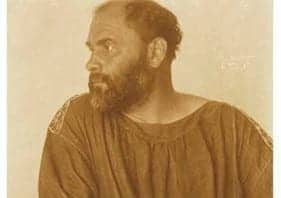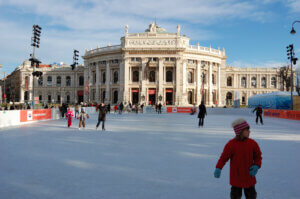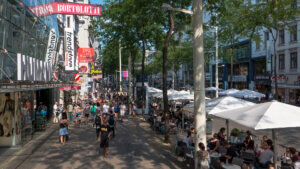At what age did his career begin?
How much did women influence his work?
What scandals shaped his life?
What made him so famous?
On our website you can find out everything you need to know about the famous painter from Vienna .
need to know
Gustav Klimt (1862-1918) – an Austrian artist of the century
Gustav Klimt was a main representative of Viennese Art Nouveau , founder of the Vienna Secession and influenced among others Egon Schiele and the young Oskar Kokoschka. Klimt portrayed the rich and beautiful women of Vienna and is considered a painter genius of the turn of the century. His portraits of women fetch top prices on the international art market.
His talent was recognized early
Gustav Klimt was born in Baumgarten near Vienna on July 14, 1862, the second of seven children of the Bohemian goldsmith Ernest Klimt and his wife Rosalia.
His career as an artist began early: at the age of 14, he received a scholarship for the School of Arts and Crafts at the Imperial-Royal Austrian Museum of Art and Industry (now the University of Applied Arts).
Together with his younger brother Ernst Klimt and classmate Franz Matsch , he founded a studio community called the Künstler-Compagnie in 1883.
The company, originally based at Sandwirtgasse 8 in Vienna and later at Josefstädter Straße 21, was quickly in demand and received numerous commissions, for example for the decoration of theaters, palaces and villas in Vienna. The company also produced curtain and ceiling paintings for the theaters in Reichenberg, Karlovy Vary and Fiume as well as murals in Peleș Castle in the city of Sinaia .
One of the main commissions was the design of the stairwells and interiors of the Burgtheater in Vienna.
The trio of painters also designed the ceiling of the Hermes Villa and the staircase in the Kunsthistorisches Museum in Vienna .
The watercolor entitled “Auditorium in the old Burgtheater”, created in 1888 and 1889, was even awarded the Imperial Prize.
Around 1890, Gustav Klimt broke away from the strong academic tradition and attempted to develop his own style .
He became more expressionistic and increasingly relied on the flat ornamentation that is so famous today and has since become typical of Klimt.
In 1891, he was accepted into the Cooperative of Fine Arts in Vienna (Künstlerhaus).
Just one year later, he had to cope with two heavy blows of fate .
After the death of his father in July 1892, he also had to say goodbye to his younger brother Ernst Klimt in December, whereupon the artists’ company was dissolved.
However, 1892 also brought positive news, at least from an artistic point of view.
The poster designed by Gustav Klimt for the International Music and Theater Exhibition in Vienna attracted a great deal of attention.
The scandal about the ceiling paintings of the University of Vienna
Art always came first for him; making major compromises for clients was not in Klimt’s interests.
This became particularly clear in the wake of one of the biggest art scandals of the 20th century.
In 1894 Klimt, together with his old companion Franz Matsch , was commissioned by the Imperial and Royal Ministry of Education to paint the ceiling of the University of Vienna. Ministry of Education commissioned the ceiling paintings of the ballroom of the Vienna University , the so-called faculty paintings.
When the main building planned by architect Heinrich von Ferstel was completed in 1884, large ceiling paintings were already planned, but were initially omitted for cost reasons.
Ten years later, the time had finally come.
The university commission responsible envisaged the “Triumph of Light over Darkness” as the central theme.
The four faculties of the university (medicine, philosophy, theology and jurisprudence) were each to be depicted in four separate pictures.
In addition,twelve so-called “spandrel pictures” were planned, each representing the personified sciences.
Criticism and awards
The commission took several years to complete.
However, as Klimt’s style developed more and more clearly from historicism towards symbolism during this time, the revised paintings also increasingly moved away from the originally approved drawings.
When Matsch and Klimt finally presented their designs to the art commission of the Ministry and the Artistic Commission of the University, they were met with mixed reactions.
While Matsch’s paintings received a rather positive assessment, Gustav Klimt’s designs were rejected by 87 members of the faculty.
After Klimt’s painting “Philosophy”, which was awarded a gold medal at the Paris World Exhibition, met with particularly fierce opposition, he was even less willing to compromise on the works “Medicine” and “Jurisprudence” than before.
The depiction of naked women in particular, but also the visually quite different styles of the two artists, led to harsh criticism.
The press largely supported this opinion at the time.
However, Gustav Klimt refused to give in to the conservative wishes of his clients.
And rightly so, as international awards proved.
But in his hometown of Vienna, he was downright hostile.
As a result, he returned the commission for jurisprudence, medicine and philosophy.
When the Ministry of Education banned him from showing the faculty paintings at the World’s Fair in St. Louis, he also gave Matsch the commission for six gusset paintings.
The founding of the Vienna Secession
On May 24, 1897, Klimt resigned from the Cooperative of Fine Arts in Vienna and, together with his friends Josef Hoffmann, Koloman Moser and other artists, founded a new artists’ association modelled on the Munich Secession, called the Vienna Secession . From 1897 to 1899 he also served as the first president of the Secession. The reason for the secession was the rejection of the prevailing conservatism and historicism.
The first exhibition took place the following year at Friedrichstraße 12 in Vienna’s 1st district.
Gustav Klimt created the famous Beethoven Frieze on the occasion of the 14th exhibition of the Secession in 1902.
He also maintained close contacts with members of the Wiener Werkstätte at the time.
Gustav Klimt was also deeply connected to the Belvedere in Vienna.
The founding of the Modern Gallery in the Lower Belvedere in 1903, for example, was the result of an initiative by Klimt and other fellow artists.
Their aim was to create a place for contemporary art from Austria and to show these paintings in an international context.
In protest against the “overly naturalistic style” of some artists, Klimt resigned from the Vienna Secession, which he had co-founded, in 1905 with a number of like-minded artists and his paintings were removed from the Secession building.
Gustav Klimt and the golden period
Klimt loved women and women loved him. The young Alma Mahler was one of his first muses.
Although the painter never married, he had intimate relationships with several women and fathered at least six children.
It is a proven fact that he was closely connected to many of his patrons.
However, the extent of his relationships with the women he portrayed can only be guessed at today.
His biography provides little information about this.
In 1902, he painted a portrait of Emilie Flöge, who became his “life person”.
He had a close friendship with the owner of the Flöge fashion salon and she was even considered his partner.
They spent many summers together at Lake Attersee in Upper Austria, where many of Klimt’s nature paintings were created.
Klimt also produced designs for reform dresses for the Flöge fashion salon.
The well-known work “Judith and Holofernes“, also known as “Judith 1”, had already been created a year earlier.
It is considered an early work of the “golden period”, which lasted around ten years and produced the artist’s most famous paintings.
It depicts a scene from the Bible: the pious widow Judith holds the head of Holofernes in her hands shortly after his beheading, with the head only partially visible on the right-hand edge.
A bloody depiction was deliberately omitted.

Record price for “Adele Bloch-Bauer I
The “Portrait of Adele Bloch-Bauer I” followed in 1907. The “Golden Adele” is one of the painter’s most important works and now hangs in the Neue Galerie in Manhattan in New York due to a restitution process . The painting was worth a whopping 135 million US dollars to entrepreneur Ronald Lauder in 2006.
The purchase price went down in history – never before had anyone spent so much on a painting.
Adele-Bloch-Bauer was the only lady to be portrayed twice by Gustav Klimt.
He painted her again in 1912, this time standing in front of a colored background.
The painting bears the significant title “Adele Bloch-Bauer II”.

The portrait of “Danaë”, a figure from Greek mythology, was painted in the same year as the “Golden Adele”.
According to tradition, she was the lover of Zeus, the father of the gods, who nourished her in the form of a shower of gold and to whom she later bore her son Perseus.
1907 was also remarkable for Austrian art history for other reasons, since it was then that he had his first personal meeting with Egon Schiele, who was considered a great admirer. Egon Schielewho was considered a great admirer of the painter. Klimt became a fatherly friend and mentor to him.

A gentle kiss that outlasts all time
Gustav Klimt’s most famous painting is undoubtedly “The Kiss”, originally titled “The Lovers”.
No other of his paintings has been reproduced more often, and the motif still adorns countless items for sale today.
The 180 × 180 cm work shows a man and a woman in happy togetherness, although the kiss that gives the work its title can only be guessed at.
The names of the lovers can also only be guessed at.
Speculation that they were Gustav Klimt and Emilie Flöge could not be substantiated.
“The Kiss” was first presented at the opening of the Vienna Art Exhibition in 1908 and is now on display in the Belvedere Vienna at Prinz-Eugen-Straße 27.

By the way, the permanent exhibition at the Belvedere not only shows a collection of well-known works from the golden period, but also paintings from Klimt’s early phase, which was still impressionistic.
Late tribute and the death of Gustav Klimt
An application for appointment as a professor at the Academy of Fine Arts in Vienna was rejected for the fourth time by the k.k. Ministry of Education rejected his application for the fourth time in 1917.
The Academy responded by unceremoniously appointing Gustav Klimt an honorary member on October 26 – Austria’s national holiday.
It was to be his last great honor during his lifetime.
On January 11, 1918, Klimt suffered a stroke in his apartment at Westbahnstraße 36, as a result of which he died in Vienna General Hospital at Alser Straße 4 on February 6, 1918.
His mortal remains were buried in the Hietzing cemetery.
Time Travel Tip:Klimt’s birthplace in Linzer Straße in 1140 Vienna is unfortunately no longer preserved; it was demolished in 1966.
However, his last studio, his villa at Feldmühlgasse 11 in Hietzing, can still be visited and is one of the most exciting sights in Vienna .
More info: Klimt Villa | Klimt’s last studio





